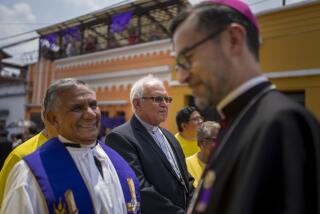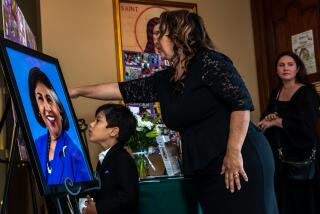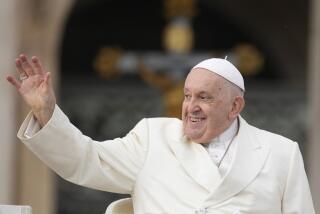Mother Teresa Exits Scripps With Pledge of Medical Aid
Mother Teresa of Calcutta was released a healthy woman Wednesday from Scripps Clinic & Research Foundation, leaving in her wake a pledge among doctors and nurses to establish a network of mobile medical clinics to serve the poor of Tijuana.
The 81-year-old Roman Catholic missionary, who won the Nobel Peace Prize in 1979 for her work among “the poorest of the poor” in Calcutta, said Wednesday that, during her stay in Tijuana, where she was stricken with pneumonia last month, she saw poverty “I have not seen anywhere else.”
She returned to Tijuana on Wednesday for one to two weeks of recuperation, after saying she hoped that, during her stay at Scripps Clinic, she persuaded American doctors that they need to minister to the poor of Tijuana as well.
Apparently Mother Teresa, ever the recruiter for charity work, was successful.
“You have to understand that, when you make rounds with Mother Teresa, it’s not just talking about heart and lungs,” said Dr. Paul Teirstein, a heart specialist who attended her. The woman is “obsessed” with the plight of the poor, he said, “and yes, it affects you, it opens your eyes.”
“There’s a sign-up sheet outside her room, and there are a dozen doctors signed up on it, and I’m sure she’ll have no trouble getting the 50 that she wants” to staff the mobile clinics, Teirstein said.
Her primary physician at Scripps, Dr. Patricia Aubanel, who also has a clinic in Tijuana, said she would now work to establish the mobile medical clinics in Tijuana, in the name of Mother Teresa’s Missionaries of Charity.
“She has given us so much joy, so many blessings” during her stay at Scripps, Aubanel said. “We know it’s going to change our lives. Hopefully, we will be better people.”
Dr. Lawrence Kline, her pulmonologist, added:
“We were all touched by her. Not just physicians, but nurses, housekeeping people. Anyone who came in touch with her and her sisters were clearly touched and moved by their dedication and purpose, and I hope that we can continue with the spirit that she has rekindled in us.
“One of the most moving things I heard her say was . . . when she told us that, in Tijuana, right near us, she’s seen the worst suffering that she’s seen anywhere.
“We should all feel embarrassed by that, because there’s no reason that all of us cannot do something to try to improve the situation in Tijuana, and I hope we will do that through Dr. Aubanel and the sisters of the Missionaries of Charity,” Kline said.
The 81-year-old Catholic missionary was declared by her doctors to be in even better health than she was a year ago and was not placed on any work or travel restrictions.
“We’re ecstatic,” Teirstein said. “Things could not have gone any better.”
Mother Teresa said she will rest at her Missionaries of Charity community in Tijuana--one of 500 convents her order has established worldwide--before traveling to New York and then Rome before returning to Calcutta.
But Mother Teresa suggested Wednesday that the poverty of Tijuana is even worse than the slums of India, where she has worked for three decades.
“I would like you all to realize that, first of all, our people in Tijuana need tender love and care. I have visited with families (there), and what I have seen, I’ve not seen anywhere else. That is why I think it is very important that we all realize that they are our brothers and sisters, and we owe them love and care and concern.”
What struck her about the plight of the Third World city adjoining San Diego was that “you don’t expect that kind of poverty” so close to the United States, she said.
Asked by a reporter whether she felt uncomfortable receiving some of the best medical care in the world while Tijuana’s residents are without medical care, she answered:
“I accept whatever God gives me, and I give to Him whatever He takes from me. So today I’m in the best of hospitals, and I’ve received the best of service, and I’m very grateful to God for giving me this beautiful gift.
“And tomorrow, if I have to go to a very poor hospital, I will be just as happy because I’m sure there, too, I will receive love. That’s the most important part.”
Mother Teresa will return to Scripps Clinic in about six months--during her annual visit to her Tijuana community--for an extensive recheck of her coronary arteries to determine whether she will need another angioplasty procedure to clear clogged arteries.
Mother Teresa was admitted to Scripps Dec. 26 with bacterial pneumonia, which triggered congestive heart failure--each a life-threatening condition.
She underwent angioplasty, a procedure in which a small balloon is inserted in her coronary arteries and then inflated, to open several clogged arteries. A tiny, cylindrical, steel-mesh device called a stent was implanted inside one of the arteries that closed back down, serving as a sort of scaffolding to keep it open.
Mother Teresa has fully recovered from the pneumonia, and now doctors are watching to make sure blood clots don’t form on the stent, loosen and cause a heart attack. For all intents and purposes, the danger period for that to occur has passed, although the woman will continue to receive several kinds of medicines to treat her heart and high blood pressure, Teirstein said.
Her last day at Scripps was concluded with a Mass in her room celebrated by Cardinal Roger M. Mahony of Los Angeles and attended by her doctors, several of her missionary sisters and several patients that came to know her during her 20-day stay.
“We prayed for joy, love, peace and unity,” she said. Teirstein, who is Jewish, left her room with a rosary tucked inside the pocket of his white doctor’s jacket.
Mother Teresa said her first priority after release was to “bring the love of God in every heart.”
“In works of love and works of peace, there is love, there is peace. That is why it is important to pray, because a fruit of prayer is a deepening of faith, and a fruit of faith is love, and a fruit of love is service, and a fruit of service is peace. That is why it is very important that we pray, to bring peace into the world.”
After her 15-minute appearance at the press conference--her head barely topping the bank of radio and television microphones--Mother Teresa walked out the front doors of the clinic under her own power, carrying a single, long-stemmed red rose given her by another of her doctors.
Her exit attracted more than 100 people--clinic employees who had worked on her and visitors at Scripps who drew up to the cordoned-off sidewalk to try to greet her or take her photograph.
“We wanted to see somebody like this who may be a saint some day,” said Ed Brennan of Los Angeles, maneuvering with his video camera for a clear shot of Mother Teresa. “We believe she will be a saint.”
Sean McGraw, a Scripps Clinic maintenance worker, stole a few minutes from his job to watch Mother Teresa leave.
“This is a historical moment, a great moment,” he said. “A woman travels all around the world, and she comes here for a little work. That’s fantastic.
“Everyone really pulled together around here while she was here,” he said. “A lot of us were spiritually touched by her presence, just knowing she was here.”
Bethel Hanger stood atop a planter box to get a better view of the woman from whom she drew blood for analysis. “I was real nervous, and she calmed me down,” Hanger laughed. “She said, ‘It’s OK.’ ”
After Mother Teresa boarded a large motor home driven by one of her benefactors, Teirstein reflected over the last 20 days of caring for one of the most famous people in the world.
“It was the experience of a lifetime, but it only gradually set in my consciousness,” Teirstein said.
Although Dr. Aubanel said she had “inner peace” while caring for Mother Teresa because her recovery “was in God’s hands and I’m just a tool,” Teirstein said he wasn’t nearly as relaxed.
“I didn’t feel that inner peace,” he conceded. “I had a very sick patient with lots of problems.”
The angioplasty procedure, he said, “was one of the most stressful things I’ve ever done, because of all the attention on us.” He said he especially remembered announcing to Mother Teresa’s missionary sisters that the procedure was successful, and their response:
“They said, ‘Do you realize how many people around the world were praying for you ? The Pope was praying for you, and 75 people in the Vatican were praying for you.’
“That was awe-inspiring.”
More to Read
Sign up for Essential California
The most important California stories and recommendations in your inbox every morning.
You may occasionally receive promotional content from the Los Angeles Times.










